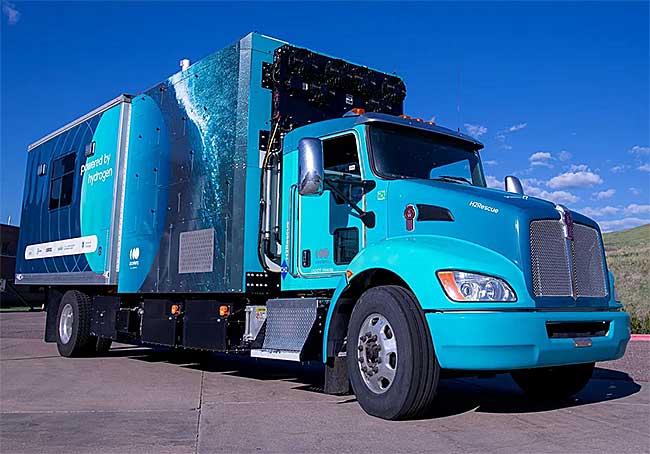
In the aftermath of a natural disaster, the race against time is critical. First responders need reliable equipment that can navigate devastated areas, provide vital resources, and keep them operational for extended periods. Enter H2Rescue, a revolutionary prototype vehicle poised to transform emergency response with its zero-emission hydrogen fuel cell technology.
Developed through a collaborative effort between the Department of Homeland Security (DHS), Department of Energy (DOE), and private sector partners, H2Rescue is more than just a truck; it’s a mobile power station designed for resilience. This hydrogen fuel cell/battery hybrid boasts several groundbreaking features:
- Zero-Emission Power: H2Rescue runs on clean hydrogen, eliminating harmful tailpipe emissions that contribute to air pollution. This is a significant advantage over traditional diesel-powered emergency vehicles, especially in disaster zones where air quality can already be compromised.
- Extended Range and Self-Sufficiency: With a driving range of up to 180 miles, H2Rescue can reach even remote disaster areas. But its true power lies in its ability to function as a self-contained power source for up to 72 hours without refueling. This extended on-site power generation eliminates dependence on a fragile grid system that might be damaged in the disaster itself.
- Multifaceted Support: H2Rescue goes beyond basic transportation. Its integrated power system can deliver up to 25 kilowatts of electricity, enough to power critical equipment, light up search areas, and even provide temporary power to shelters or field hospitals.
- Disaster Relief Capabilities: The byproducts of H2Rescue’s hydrogen fuel cell reaction include heat and clean water, essential resources in disaster zones. It can generate up to a gallon of water per hour, aiding in dehydration prevention and basic hygiene needs for both first responders and survivors.
- Silent Operation: Unlike the roar of a diesel engine, H2Rescue operates with near silence. This creates a calmer environment for first responders to communicate and coordinate rescue efforts, while also minimizing noise disturbance for those already traumatized by the disaster.
The impact of H2Rescue extends far beyond its immediate functionalities. Here’s how this innovative vehicle can revolutionize emergency response:
- Faster Deployment: H2Rescue’s self-sufficiency allows for quicker mobilization to disaster zones without waiting for traditional fuel supplies to be replenished. This critical time saved can mean the difference between life and death during search and rescue operations.
- Enhanced Operational Flexibility: The ability to generate on-site power frees first responders from relying on a potentially damaged electrical grid. This empowers them to set up field hospitals, communication centers, and base camps with greater flexibility and independence.
- Improved Public Safety: The elimination of harmful emissions contributes to cleaner air, improving the health and safety of both first responders and survivors alike. Additionally, the quieter operation allows for clearer communication and reduces noise pollution in already stressful situations.
- Environmental Sustainability: H2Rescue embodies a commitment to a greener future for emergency response. By minimizing reliance on fossil fuels, it reduces greenhouse gas emissions and paves the way for a more sustainable approach to disaster management.
While H2Rescue is still in the prototype stage, successful testing by the National Renewable Energy Lab (NREL) has generated significant optimism. As with any new technology, challenges remain. Developing a robust hydrogen infrastructure for refueling these vehicles will be crucial for widespread adoption. Additionally, ensuring the safety and efficiency of hydrogen storage onboard the vehicle requires ongoing research and development.
However, the potential benefits of H2Rescue are undeniable. It represents a significant leap forward in emergency vehicle technology, offering a cleaner, more efficient, and life-saving solution for disaster response. As H2Rescue continues its development and testing phase, it paves the way for a future where emergency response is not just about saving lives, but also about protecting the planet in the process.
Citation